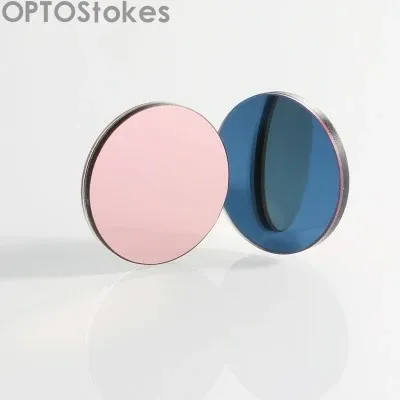What Exactly Is a Thin-Film Optical Filter?

Thin-film optical filters are precision devices created by alternately depositing dielectric layers of different refractive indices onto optical-grade substrates—most commonly fused silica or B270 glass. As light enters the layer stack, constructive and destructive interference within each nanometer-scale layer steers individual wavelengths toward transmission, reflection, or absorption. By tailoring layer count, thickness, and material composition, engineers can sculpt virtually any spectral profile across 200 nm to 2500 nm, making these filters critical in precision optical systems.
Five Key Types of Optical Filters
1. Bandpass Filters
Transmit a defined wavelength window while rejecting adjacent light. Modern specifications focus on passband range, transmission level, and required blocking range (replacing legacy metrics like half-power bandwidth/HPBW). Performance is optimized for 0° angle of incidence (AOI); tilting or using high-cone angles shifts the passband and introduces polarization splitting. "Squareness" of the spectral curve is controlled by cavity count (Fabry-Perot designs) or longpass/shortpass (LWP/SWP) layer pairs. Ideal for fluorescence microscopy and laser spectroscopy.
2. Short-Pass Edge Filters
Transmit shorter wavelengths while blocking longer ones, enabling clean separation of low-wavelength light in systems like UV imaging setups.
3. Long-Pass Edge Filters
Block shorter wavelengths and transmit longer ones, commonly used in infrared spectroscopy and excitation/emission path isolation in fluorescence systems.
4. Dichroic Filters
Operate at 45° AOI (standard mounting angle), reflecting one wavelength band while transmitting another. The spectral gap between bands directly impacts coating complexity and cost—tighter gaps require thicker coatings and stricter tolerances. Performance improves with narrower beam angles and better collimation. Used for beam combining in microscopy and display systems.
5. Notch Filters
Reject a single narrow wavelength band while transmitting all other light, making them ideal for laser cleanup (e.g., removing excitation lines in Raman spectroscopy).
Key Specification Tips for Optimal Performance
Start by mapping your light source and detector response curves—specifying blocking/transmission outside these ranges adds unnecessary cost. Use average optical density (OD) levels unless isolating discrete laser lines; note that thin-film OD spikes are spectrally narrow and rarely affect signal-to-noise ratio. AOI matters: keep bandpass, notch, and edge filters at low angles (0° preferred), while dichroics are optimized for 45° AOI. Tighter beam cone angles improve performance across all types.
Beyond Standard: Multi-Band & Custom Filters
While standard filters cover most needs, OEM systems often require multi-band, multi-notch, or solar-simulating profiles. Multi-band filters integrate multiple passbands into one substrate, reducing instrument size; multi-notch/dichroic coatings do the same for blocking or beam-combining tasks. OPTOStokes offers hundreds of off-the-shelf filters for immediate shipment and can engineer custom spectra—matching any wavelength requirement with precision dielectric layering, often within three weeks.
Optimize Your Optical Path Today
From fluorescence microscopes and Raman spectrometers to telecom modules and solar-imaging payloads, precise spectral control is critical. Whether you need a stock bandpass filter overnight or a custom multi-band solution with tight AOI tolerances, send your wavelength list and mechanical specs to sales@optofilters.com. Our coating engineers will return a detailed drawing and quote within 24 hours—no minimum order quantity, no hidden tooling fees.


